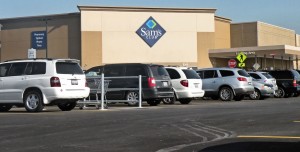The stream of cars that will file into the Glen Carbon Sam’s Club for the grand opening today will give the impression that there was never a doubt the store would open. It was not long ago, however, that the development was almost shelved.
The Sam’s Club project, first proposed in March 2011, seemed to be under a black cloud from the onset. The developers of the 14.6-acre site on Illinois Route 159, near Center Grove Drive, knew the soil was likely creosote-contaminated. It is believed the soil became contaminated nearly 100 years ago when a railroad tie processing facility operated there. However, testing revealed that concrete on the site, as well as the soil, was creosote-contaminated.
A heavy-duty wood preservative, primarily used for railroad ties and utility poles, creosote was determined to be a possible carcinogen and banned for retail use by the Environmental Protection Agency in 1986. Creosote’s industrial use is tightly regulated by the EPA to ensure no human receives heavy exposure to the chemical.
Although creosote is still in use today, it is classified by the Environmental Protection Agency as hazardous waste, which is not unusual, Bob Johnson, environmental consultant to the Village of Glen Carbon on the Sam’s Club project, said.
“Almost all materials that are hazardous waste have a valid use,” Johnson said. “The question is how to dispose of it after its use as a product,” Johnson said.
Despite being classified as a hazardous waste, Johnson said the creosote on the Sam’s Club site did not present an environmental risk.
“Wal-Mart (parent company of Sam’s Club) is spending millions of dollars that didn’t have to be spent just to be sure it’s taken care of,” Johnson said. “Their concern is that someone will try to make it an issue that isn’t.” The creosote-contaminated soil was shipped to Texas and the contaminated concrete to Michigan, the nearest disposal facility for each, respectively, Johnson said.
Non-native soil was also discovered on the site. It is unclear when the soil was shipped to the site, but it accounted for a three-foot layer of dirt that would not compact properly. It had to be removed and replaced with better soil.
The lot also sits on an abandoned coal mine. The mine voids had to be filled with grout to ensure the ground did not sink under the weight of the new store. This, too, was a known issue to the original developer, THF, and the current developer, UTW Realty. However, the cost of addressing mine subsidence was set to run nearly $1 million higher than originally estimated.
“It was the mine issue that nearly scuttled the deal,” Johnson said.
The decision to proceed was assisted by Glen Carbon agreeing to contribute an additional $800,000 in tax reimbursements to UTW Realty. The village originally committed $5.9 million, but agreed to increase the amount to $6.7 million when it was discovered that the cost of addressing mine subsidence was underestimated.
The decision to increase the reimbursement amount was not a difficult one, Johnson said.
“If this deal didn’t go through, that land probably would be left vacant forever,” Johnson said. “It was a once-in-a-lifetime opportunity for Glen Carbon.” It took a company with the financial resources of Wal-Mart to clean up the property, Johnson said.
The $6.7 million the village is paying is only a small part of the project’s total cost, Village Administrator Jamie Bowden said. Bowden estimated it cost about $33 million to get the Sam’s Club location operational.
“It is a correct statement to say the reimbursement is covering environmental plus mine subsidence costs,” Bowden said.
Glen Carbon created a new business district to generate additional sales tax that will be reimbursed to the property’s developers. Sam’s Club is the only business in the new district, Bowden said.
The special district calls for an additional 1 percent sales tax for up to 23 years. Half of the tax revenue will go to the Village and the other half to the developer, Bowden said, until the $6.7 million tab is paid.
Bowden said the conservative estimate – based on sales at similar Sam’s Clubs – is that the special business district can be dissolved in 13 years. Glen Carbon estimates the village will receive $375,000 annually while the special business district is in place and double that amount after the district is dissolved.




